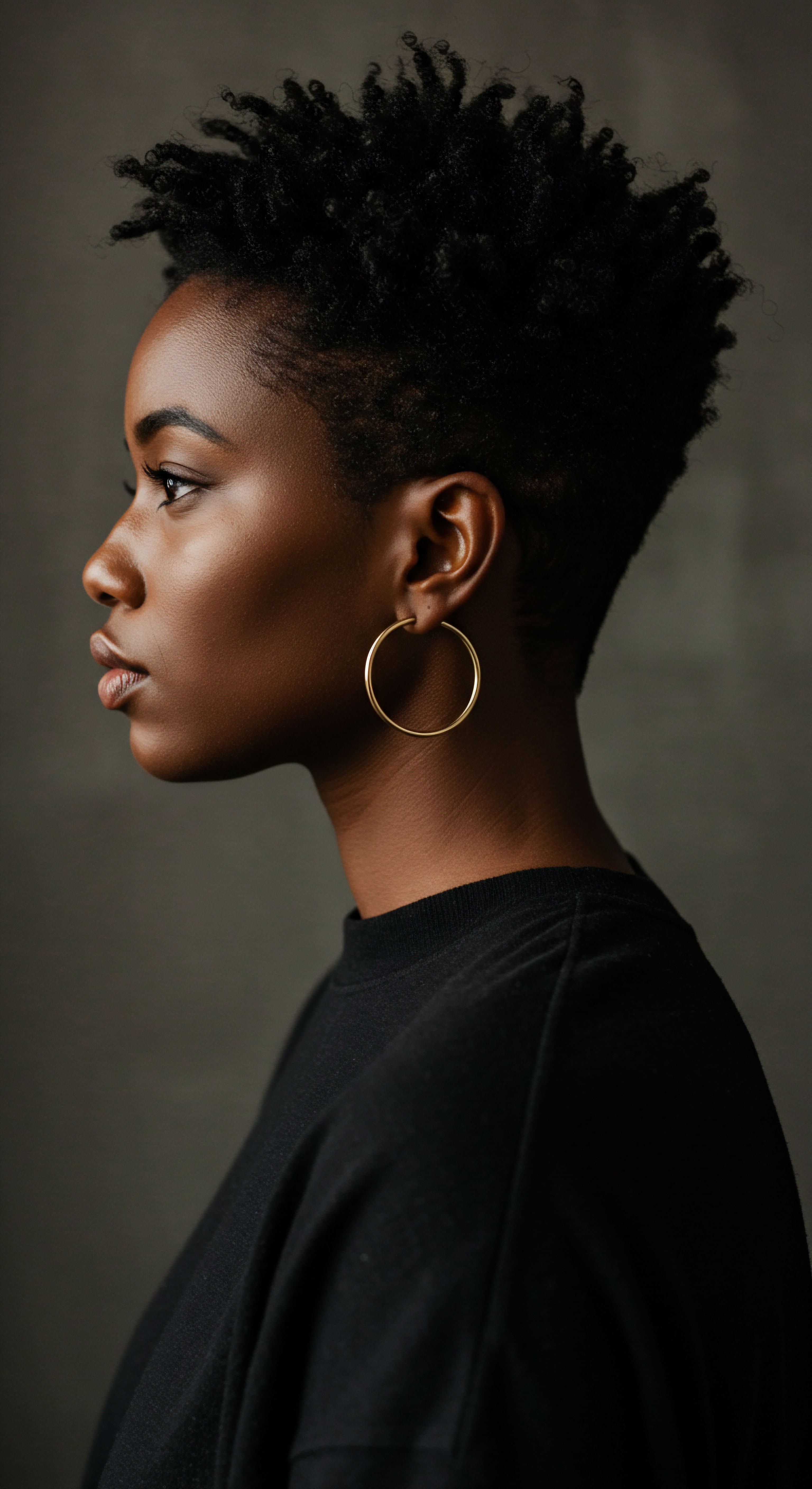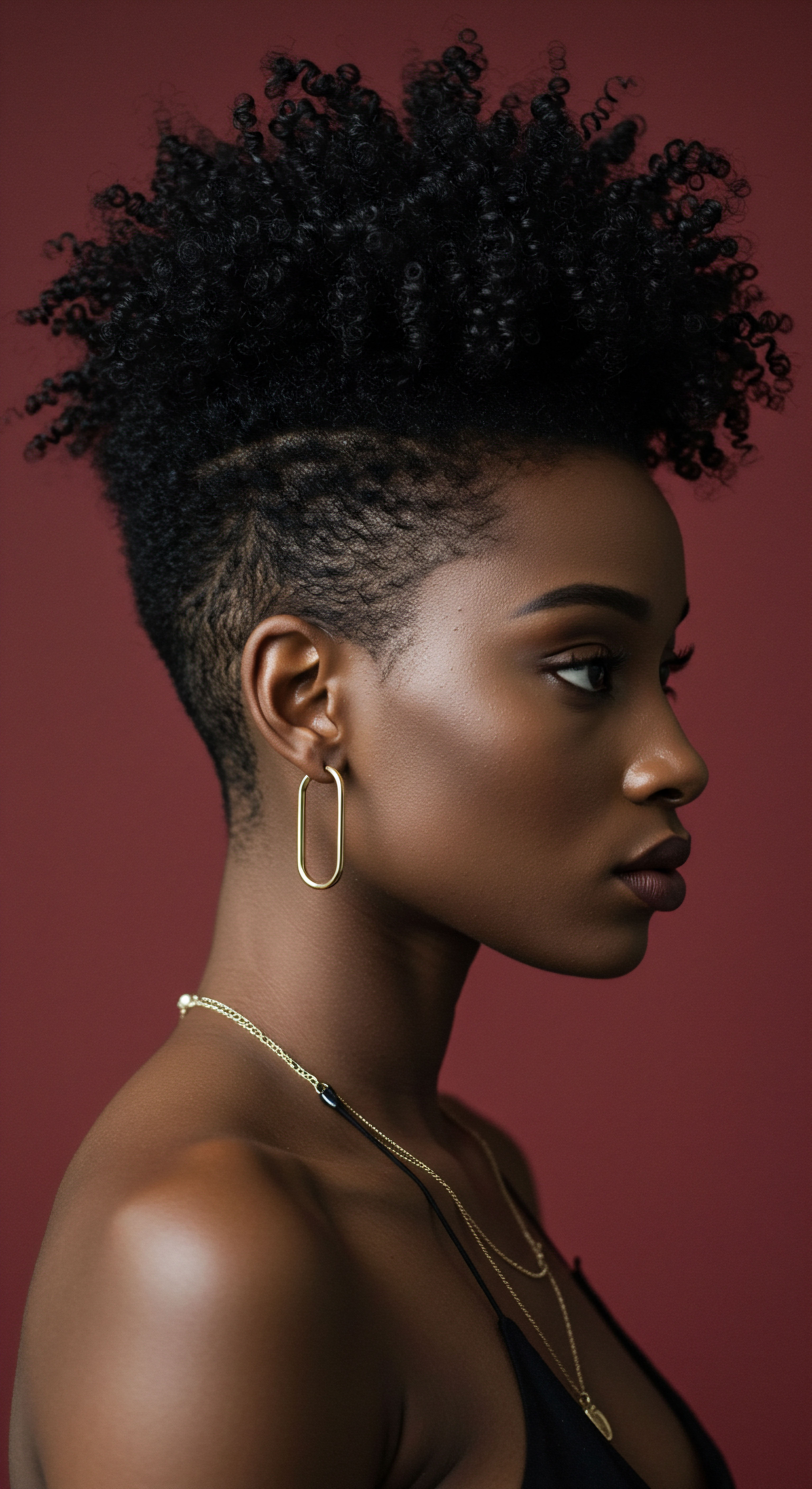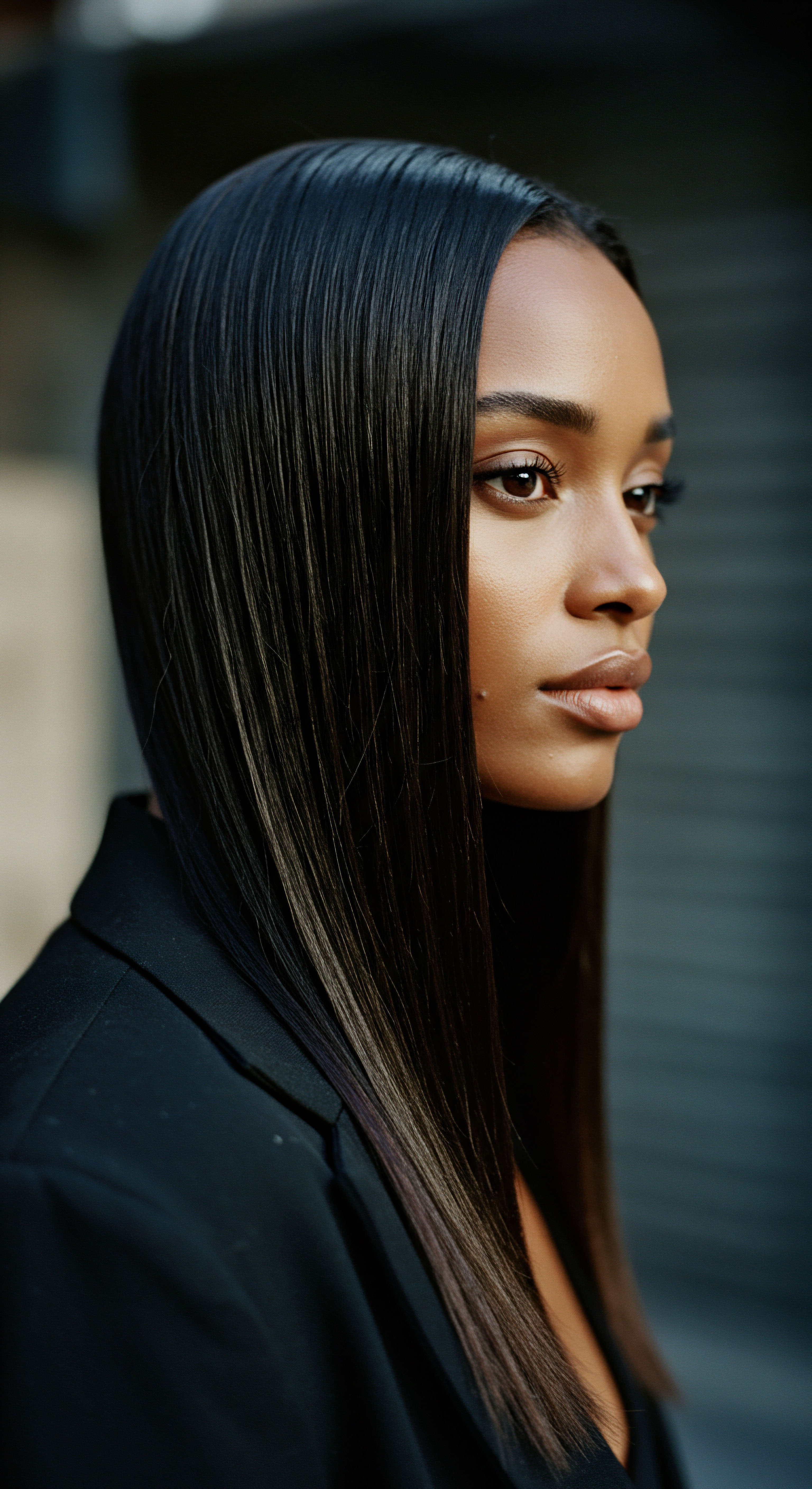
Roots
Consider for a moment the profound connection we share with our hair, a connection that runs deeper than mere aesthetics or fleeting trends. It is a biological marvel, an extension of our very being, carrying whispers of our heritage and the quiet stories of our daily lives. Within each strand, a universe of intricate components works in concert, and among these, lipids stand as unsung protectors, silent guardians of our hair’s inherent vitality. To truly understand our hair, particularly textured hair, one must begin at its foundational elements, delving into the very substances that give it strength, resilience, and its characteristic luster.
Hair, though seemingly simple, is a complex biological material, composed primarily of proteins, yet with a significant, often overlooked, contribution from lipids. These fatty, waxy, and oily substances make up a smaller percentage of hair’s dry weight, typically ranging from 1% to 9%, but their impact on hair health and appearance is disproportionately large. They reside both on the hair’s surface and deep within its shaft, acting as vital architectural elements and protective layers.

What are the Primary Lipid Classifications within Hair?
The lipids found in hair can be categorized in several ways, reflecting their origin and their placement within the hair fiber. A fundamental distinction exists between Exogenous Lipids and Endogenous Lipids. Exogenous lipids are those that originate from external sources, primarily the sebaceous glands on the scalp, which produce sebum.
This oily secretion coats the hair shaft, providing a natural conditioning and protective layer. Endogenous lipids, by contrast, are those synthesized within the hair matrix cells themselves, becoming an integral part of the hair’s internal structure as it grows.
Beyond their origin, lipids are also classified by their location ❉ Surface Lipids and Internal Lipids. Surface lipids are found on the outermost layer of the hair, primarily on the cuticle, where they contribute to shine, smoothness, and protection from environmental aggressors. Internal lipids, however, are embedded within the deeper layers of the hair shaft, particularly in the cell membrane complex (CMC) between cuticle cells and within the cortex. These internal lipids are crucial for maintaining structural integrity, cell cohesion, and regulating water movement within the hair fiber.
Hair lipids, though a small fraction of total hair weight, are silent architects of its resilience and appearance.

Core Lipid Types and Their Roles
A closer look at the chemical makeup of these lipids reveals a fascinating array of molecules, each with specific functions.
- 18-Methyleicosanoic Acid (18-MEA) ❉ This is a particularly significant lipid, especially on the cuticle. It is a covalently bound fatty acid, meaning it is chemically attached to the cuticle surface via a thioester bond. 18-MEA provides a hydrophobic, or water-repelling, surface to the hair, which is vital for preventing excessive water absorption, maintaining smoothness, and reducing friction. Its presence is directly linked to hair’s natural shine, softness, and ease of combing.
- Ceramides ❉ These are a class of waxy lipids that play a structural role, particularly within the cell membrane complex (CMC) between the cuticle cells and in the cortex. Ceramides act as a “cement” that binds the cuticle cells together, contributing to the hair’s barrier function and preventing moisture loss. Their presence helps maintain the integrity of the hair shaft and its resistance to damage.
- Cholesterol (CH) and Cholesterol Sulfate (CS) ❉ Cholesterol and its sulfated form are also present in hair, both as exogenous and endogenous lipids. They contribute to the overall lipid barrier, supporting the hair’s structural properties and water retention.
- Free Fatty Acids (FFAs) ❉ These are components of both exogenous and endogenous lipids. They contribute to the hair’s surface properties and internal structure, affecting moisture balance and mechanical strength. Palmitic acid and oleic acid are examples of fatty acids found in hair.
- Triglycerides and Wax Esters ❉ Primarily exogenous lipids, these are components of sebum and coat the hair surface. They provide lubrication and contribute to the hair’s protective barrier against environmental elements. Squalene is another important exogenous lipid, particularly abundant in African hair.
The interplay of these lipid types creates a sophisticated protective system. For instance, the hydrophobic nature imparted by 18-MEA on the cuticle surface acts as a primary defense against external moisture and environmental stressors. Deeper within, ceramides reinforce the intercellular connections, ensuring the hair’s structural coherence. This layered defense is a testament to the hair’s natural design, allowing it to withstand the daily rigors of life while maintaining its inherent beauty.

Ritual
Stepping from the quiet contemplation of hair’s inner workings, we arrive at the practical realm of ritual—the deliberate actions and mindful choices that shape our hair’s daily experience. Understanding the core lipids is not an abstract exercise; it is a grounding for the very ways we care for our hair, influencing every wash, every condition, every styling choice. Our rituals, whether simple or elaborate, hold the power to either protect and replenish these vital lipids or, inadvertently, diminish their protective presence.
The external environment, along with our hair care practices, significantly impacts the lipid content of our hair. Daily grooming, chemical treatments, and exposure to environmental elements like UV radiation can all lead to lipid loss, affecting hair’s tensile strength, shine, and overall health. Recognizing this dynamic relationship between our actions and the hair’s lipid layers allows us to cultivate rituals that truly serve our strands.

How do Daily Hair Care Choices Affect Hair Lipids?
The products we choose and the methods we employ in our hair care routines have a direct impact on the integrity of hair lipids. Shampoos, especially those with strong surfactants, can remove lipids from the hair surface. While cleansing is necessary, excessive or harsh washing can strip away protective lipid layers, leading to dryness, increased friction, and a dull appearance.
Conditioners and masks, on the other hand, play a vital role in replenishing lost lipids and smoothing the hair’s outer surface. Many hair care products are formulated with lipid-based ingredients, such as natural plant oils, fats, waxes, and phospholipids, which aim to restore the hair’s lipid barrier. These products can help seal the cuticle, minimize moisture loss, and improve hair texture and shine.
| Practice Harsh Cleansing |
| Effect on Lipids Removes surface lipids, potentially internal ones. |
| Hair Outcome Dryness, increased friction, dullness. |
| Practice Chemical Treatments |
| Effect on Lipids Depletes 18-MEA, free lipids; degrades internal lipids. |
| Hair Outcome Brittle texture, increased porosity, reduced shine. |
| Practice Conditioning & Masking |
| Effect on Lipids Replenishes surface lipids, seals cuticle. |
| Hair Outcome Improved shine, softness, moisture retention. |
| Practice Heat Styling |
| Effect on Lipids Can strip away lipids and break down protein structure. |
| Hair Outcome Loss of smoothness, increased frizz, weakened structure. |
| Practice Understanding these effects helps tailor hair care for optimal lipid health. |

Protecting the Lipid Barrier
A conscious approach to hair care involves choosing products and practices that respect the hair’s natural lipid balance. For textured hair, which can often be prone to dryness due to its structural characteristics, maintaining this lipid barrier is particularly significant. Opting for gentle, sulfate-free cleansers can help preserve the hair’s natural oils, preventing unnecessary stripping. Following cleansing with a rich conditioner or deep conditioning treatment helps to deposit beneficial lipids back onto the hair shaft, fortifying its outer layer.
Consider the practice of oiling, a tradition deeply rooted in many cultures. Oils like argan, shea, and soybean, rich in fatty acids, can supplement the hair’s natural lipid content, providing external protection and enhancing shine. While external oils cannot truly restore internal, covalently bound lipids like 18-MEA, they do form a protective coating that can temporarily mitigate the effects of lipid loss, improving smoothness and reducing frizz. This mindful layering of care products, informed by an understanding of lipid function, forms a powerful ritual for hair well-being.
Our hair care choices, from gentle cleansing to enriching treatments, are direct acts of care for its lipid architecture.

The Significance of Moisture Balance
Lipids are central to the hair’s ability to retain moisture. They form a semi-permeable barrier that regulates the passage of water, preventing excessive evaporation from the hair shaft while also repelling too much external moisture that could lead to frizz or structural disruption. When this lipid layer is compromised, hair becomes more susceptible to changes in humidity, absorbing water more readily and leading to increased frizz and a weakened structure.
A holistic approach to hair wellness acknowledges that the hair’s lipid health is not isolated but connected to overall bodily well-being. Diet plays a part, with the inclusion of healthy fats, such as omega-3 and omega-6 fatty acids, contributing to the body’s ability to produce essential lipids that support scalp and hair health. These internal contributions lay a foundation for the external care rituals we practice, creating a harmonious system that supports radiant, resilient hair.

Relay
As we move beyond the immediate actions of daily care, a deeper inquiry into hair lipids reveals an intricate interplay of biological nuances, cultural contexts, and the profound impact of external forces. The scientific lens offers a detailed view of these microscopic guardians, showing us how their very structure dictates hair’s response to the world, and how differences in lipid composition across populations contribute to the unique characteristics of textured hair. This is where science meets lived experience, where the chemical bonds tell stories of resilience and vulnerability.
Hair lipids, though minor in mass compared to proteins, are highly active participants in maintaining hair’s mechanical properties, its barrier function, and its overall aesthetic. They are not merely passive coatings; they are dynamic molecules that respond to environmental challenges and chemical interventions. Understanding their precise chemical structures and locations within the hair fiber is paramount to developing truly effective and respectful hair care solutions.

What is the Role of Lipids in the Hair’s Cell Membrane Complex?
The Cell Membrane Complex (CMC) is a crucial lipoprotein component that acts as an intercellular cement, binding together the various cells within the hair shaft, including the cuticle cells and cortical cells. Lipids within the CMC, particularly ceramides, cholesterol, and free fatty acids, are organized into lamellar structures. These lipid bilayers are vital for cell cohesion, regulating the diffusion of molecules into and out of the hair fiber, and contributing significantly to the hair’s mechanical strength and flexibility.
When the CMC is damaged, for instance, through chemical treatments like bleaching or coloring, its lipid content is depleted, leading to increased porosity and reduced mechanical integrity. This degradation of the internal lipid lamellae can result in hair that feels rough, appears dull, and is more prone to breakage. The delicate balance of lipids within the CMC is a cornerstone of hair health, acting as an internal shock absorber and moisture regulator.

How do Ethnic Differences Influence Hair Lipid Profiles?
The diverse textures and characteristics of human hair across different ethnic groups are not solely due to protein variations but also involve distinct lipid profiles. Research indicates that the amount and types of lipids present in hair can vary significantly among African, Asian, and Caucasian hair types.
A notable study highlighted that African Hair generally possesses a higher total lipid content, with some reports suggesting it can be 1.7 times higher in internal lipids compared to Caucasian and Asian hair. This hair type often presents higher quantities of cholesterol esters, free fatty acids, and cholesterol sulfate. Interestingly, despite this higher lipid content, African hair can exhibit lower moisturization and less radial swelling when exposed to water. This apparent paradox might be explained by the arrangement of these lipids; African hair has been shown to contain more lipids that are highly disordered, which can affect its permeability to water and chemical treatments.
Conversely, Asian Hair has been observed to have more integral hair lipids, particularly free fatty acids, and demonstrates greater resistance to damage from ultraviolet radiation, possibly due to the lipids’ capacity to absorb UVR. Caucasian Hair, while having different lipid distributions, may exhibit higher hydration levels due to a lower diffusion coefficient, indicating decreased permeability compared to Afro-textured hair.
Hair’s unique lipid blueprint varies across ethnic backgrounds, shaping its resilience and response to external factors.
This variation in lipid composition and organization is not merely a scientific curiosity; it carries practical implications for hair care. For example, the disordered lipid structure in African hair could mean it is more permeable to hair dyes or treatments, requiring tailored approaches to minimize damage. This underscores the need for hair care science to move beyond generalized solutions, recognizing and responding to the inherent biological diversity of hair.

Can Hair Lipids Be Restored after Depletion?
The question of lipid restoration after damage is a complex one. When hair undergoes processes like bleaching, perming, or even aggressive washing, essential lipids, particularly 18-MEA and other free lipids, are significantly depleted. Bleaching, for instance, can remove over 80% of 18-MEA in a single treatment, oxidizing its bonds. This loss leads to a more hydrophilic (water-loving) surface, increased friction, and a dry, brittle feel.
While external lipid-based products like conditioners, oils, and masks can deposit a layer of lipids onto the hair surface, providing temporary smoothness, shine, and protection, they cannot truly restore the covalently bound lipids or perfectly replicate the intricate internal lipid structures that are lost. These products act as a “bandage,” improving the appearance and feel of the hair by creating a protective coating, but they do not fully rebuild the molecular architecture of the natural lipid layers.
Research into this area continues, with some cosmetic innovations aiming to deliver fatty alcohols into the hair’s lipid-rich regions, such as the cell membrane complex and medulla, to help improve structural integrity. However, the complete, intrinsic restoration of hair’s natural lipid profile, especially the bound lipids, presents a significant challenge. This reality reinforces the critical importance of preventative care and gentle practices to preserve the hair’s native lipid content.
| Hair Type African Hair |
| Key Lipid Observations Highest total lipid content, particularly cholesterol esters, FFAs, cholesterol sulfate. Lipids often highly disordered. |
| Implications Potentially higher permeability to treatments, lower natural moisturization despite lipid content. |
| Hair Type Asian Hair |
| Key Lipid Observations More integral hair lipids, higher free fatty acid content. |
| Implications Greater UV radiation resistance. |
| Hair Type Caucasian Hair |
| Key Lipid Observations Similar lipid distribution, but higher lipid order in cuticles than African/Asian. |
| Implications Higher hydration levels due to lower water diffusion. |
| Hair Type These variations highlight the need for tailored hair care approaches. |
The scientific journey into hair lipids continues to reveal their profound impact on hair health and characteristics. From the protective shield of 18-MEA to the intercellular cement of ceramides, these molecules are far more than mere oils. They are dynamic players in the hair’s structural integrity, moisture balance, and its unique response to the world, particularly within the diverse landscape of textured hair. Recognizing their importance allows for a more informed and respectful approach to hair care, one that honors the inherent biology of each strand.

Reflection
Our journey through the world of hair lipids has been a quiet revelation, pulling back the veil on the invisible forces that shape our strands. We have seen that beyond the visible curls and coils, beyond the daily rituals of care, lies a delicate ecosystem of fatty acids, ceramides, and cholesterols, each playing a vital, unsung role. This understanding shifts our perspective from superficial concerns to a deeper reverence for the hair’s inherent design. It reminds us that true hair wellness begins with an appreciation for its fundamental biology, allowing us to move with gentle wisdom, honoring its natural composition and responding to its authentic needs.

References
- Alves, A. P. & Cadena, R. S. (2023). Hair Lipid Structure ❉ Effect of Surfactants. Cosmetics, 10(4), 107.
- Pinho, M. Coderch, L. & Martí, M. (2023). The influence of hair lipids in ethnic hair properties. International Journal of Cosmetic Science, 45(2), 227-234.
- Pereira, A. D. S. & de Almeida, J. S. (2023). Lipids in hair cosmetics ❉ role, benefits and selection features. BRAZIL-PROF.
- Spreading Clean Beauty. (n.d.). Lipid layer ❉ what it is, its function and how to take care of it. Retrieved from Spreading Clean Beauty.
- Shin, H. W. Lee, H. J. & Kim, Y. H. (2012). The Ethnic Differences of the Damage of Hair and Integral Hair Lipid after Ultra Violet Radiation. Korean Journal of Investigative Dermatology, 19(2), 127-134.
- Brillare. (2021). Lipids are the unsung heroes of the hair. Retrieved from Brillare.
- Ghasemi, A. & Khazaei, M. (2024). Chemistry of Wellness ❉ Hair and Hair Care. American Chemical Society.
- Chevalier, M. & Melot, M. (2022). The Role of Lipids in the Process of Hair Ageing. Cosmetics, 9(6), 124.
- K18 PRO. (n.d.). Science Class 16 ❉ Lipids + hair health. Retrieved from K18 PRO.
- K18 PRO. (n.d.). The Science of Heat Protection by Oil. Retrieved from K18 PRO.
- Coderch, L. Martí, M. & Barba, C. (2021). A study shows that the differences between African, Caucasian and Asian hair are determined by their lipid distribution. Biotech Spain.
- Clinikally. (2023). Revitalise Your Tresses ❉ Influence of Omega-3 Fatty Acids on Hair Health. Retrieved from Clinikally.
- Robbins, C. R. (2014). Chemical and physical behavior of human hair (5th ed.). Springer.
- McMullen, R. & Jachowicz, J. (2003). Analysis of hair lipids and tensile properties as a function of distance from scalp. Journal of Cosmetic Science, 54(4), 387-402.
- Gam, A. C. & Goulart, M. (2023). The Genomic Variation in Textured Hair ❉ Implications in Developing a Holistic Hair Care Routine. Cosmetics, 10(4), 114.
- Ruetsch, S. B. & Kamath, Y. K. (2005). Hair fiber characteristics and methods to evaluate hair physical and mechanical properties. Journal of Cosmetic Science, 56(2), 125-144.
- Martí, M. & Coderch, L. (2022). The Role of Lipids in the Process of Hair Ageing. Cosmetics, 9(6), 124.